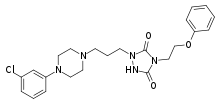Triazoledione
Triazoledione (developmental code name BMS-180492) is a phenylpiperazine compound and a major metabolite of the antidepressant nefazodone.[2][3] It is active, but with substantially reduced potency compared to nefazodone (approximately one-seventh).[3][2] As such, it has been suggested that it is unlikely that triazoledione contributes significantly to the pharmacology of nefazodone.[3] However, triazoledione may reach concentrations as great as 10 times those of nefazodone, and hence could still be a significant contributor to its therapeutic effects.[2]
 | |
| Clinical data | |
|---|---|
| Other names | BMS-180492 |
| Pharmacokinetic data | |
| Elimination half-life | 18 hours[1] |
| Identifiers | |
IUPAC name
| |
| CAS Number | |
| PubChem CID | |
| ChemSpider | |
| UNII | |
| ChEMBL | |
| Chemical and physical data | |
| Formula | C23H28ClN5O3 |
| Molar mass | 457.96 g·mol−1 |
| 3D model (JSmol) | |
SMILES
| |
InChI
| |
Pharmacology
| Site | Ki (nM) | Species | Ref |
|---|---|---|---|
| SERT | ≥34,527 ≥26,471 | Human Rat | [5] [5][3] |
| NET | >100,000 100,000 | Human Rat | [5] |
| DAT | ND | ND | ND |
| 5-HT1A | 636–1,371 | Rat | [3][5] |
| 5-HT2A | 159–211 | Rat | [5][3] |
| 5-HT2C | ND | ND | ND |
| α1 | 173 1,000 | Human Rat | [5] [3] |
| α2 | 1,915 1,000 | Human Rat | [5] [3] |
| β | >100,000 | Rat | [3] |
| H1 | 11 | Guinea pig | [5] |
| mACh | >100,000 | Rat | [5] |
| Values are Ki (nM). The smaller the value, the more strongly the drug binds to the site. | |||
Triazoledione shows significant affinity for the serotonin 5-HT1A and 5-HT2A receptors, the α1-adrenergic receptor, and the histamine H1 receptor.[3][5] It shows negligible affinity for the serotonin and norepinephrine transporters and the muscarinic acetylcholine receptors.[3][5]
| Compound | 5-HT1A | 5-HT2A | SERT | NET | α1 | α2 | β | H1 | mACh |
|---|---|---|---|---|---|---|---|---|---|
| Hydroxynefazodone | 56–589 | 7.2–34 | 165–1,203 | 376–1,053 | 8.0–145 | 63–2,490 | >1,000 | 28 | 11,357 |
| mCPP | 16–411 | 110–433 | 127–432 | 490–4,360 | 97–763 | 112–371 | 4,890 | 449 | 4,702 |
| Nefazodone | 52–1,030 | 7.1–32 | 181–549 | 200–713 | 5.5–144 | 84–41,700 | >100,000 | 30 | 4,569 |
| Trazodone | 42–288 | 11–20 | 115–690 | ≥20,887 | 12–23 | 106–1,070 | 47,100 | 29 | 12,188 |
| Triazoledione | 636–1,371 | 159–211 | ≥26,471 | >100,000 | ≥173 | ≥1,915 | >100,000 | 11 | >100,000 |
| Values are Ki (nM). The smaller the value, the more strongly the drug binds to the site. | |||||||||
References
- Alan F. Schatzberg, M.D.; Charles B. Nemeroff, M.D., Ph.D. (2017). The American Psychiatric Association Publishing Textbook of Psychopharmacology, Fifth Edition. American Psychiatric Pub. pp. 460–. ISBN 978-1-58562-523-9.CS1 maint: multiple names: authors list (link)
- Sheldon H. Preskorn; Christina Y. Stanga; John P. Feighner; Ruth Ross (6 December 2012). Antidepressants: Past, Present and Future. Springer Science & Business Media. pp. 68–. ISBN 978-3-642-18500-7.
- Davis R, Whittington R, Bryson HM (1997). "Nefazodone. A review of its pharmacology and clinical efficacy in the management of major depression". Drugs. 53 (4): 608–36. doi:10.2165/00003495-199753040-00006. PMID 9098663.
- Roth, BL; Driscol, J. "PDSP Ki Database" (HTML). Psychoactive Drug Screening Program (PDSP). University of North Carolina at Chapel Hill and the United States National Institute of Mental Health. Retrieved 14 August 2017.
- Owens MJ, Morgan WN, Plott SJ, Nemeroff CB (1997). "Neurotransmitter receptor and transporter binding profile of antidepressants and their metabolites". J. Pharmacol. Exp. Ther. 283 (3): 1305–22. PMID 9400006.